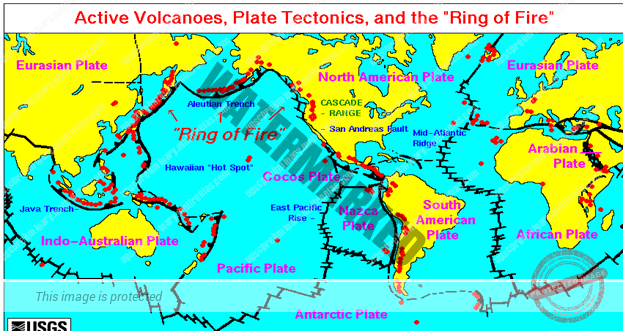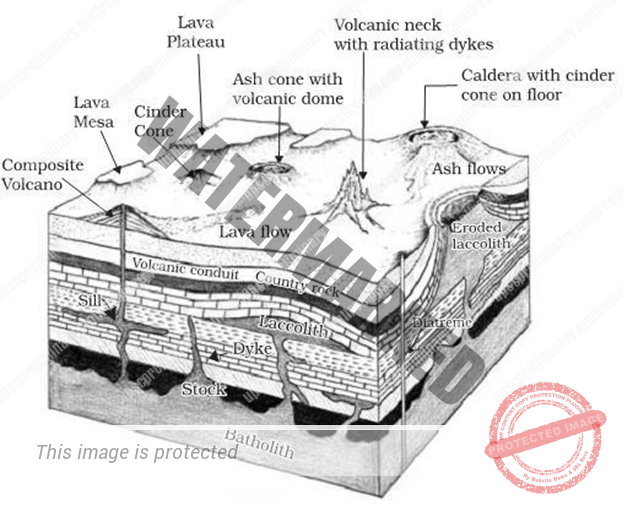- VOLCANO
- FEATURES OF VOLCANO
- TYPES OF VOLCANOES
- EFFECTS OF VOLCANIC ACTIVITIES
- DISTRIBUTION OF VOLCANOES
- VOLCANIC LANDFORMS
- INTRUSIVE IGNEOUS ROCKS
UNIT 2 – EARTH – PART 4
VOLCANO
A Volcano is a vent (opening) in the earth’s crust through which molten material erupts suddenly.
Volcanism is the phenomenon of eruption of molten rock (magma) onto the surface of the Earth or a solid-surface planet or moon, where Lava, Pyroclastic and Volcanic Gases erupt through a break in the surface called a Vent.
FEATURES OF VOLCANO
The molten rock material found in the interior of the earth is called Magma. When it reaches the earth’s surface, it is known as Lava. The material that reaches the ground includes Lava Flows, Pyroclastic Debris, Volcanic Bombs, Ash & Dust, gases such as Nitrogen Compounds, Sulphur Compounds and minor amounts of Chlorine, Hydrogen And Argon.
Crater is a saucer shaped depression in the mouth of a volcano. When the crater is widened, it is called as Caldera. When they erupt they tend to collapse on themselves rather than building any tall structure. The collapsed depressions are called calderas.
TYPES OF VOLCANOES
Based on the Frequency of Eruption, there are three types of volcanoes.
- Active Volcanoes: Volcanoes which erupt frequently are called active volcanoes. Generally, their vent remains open.
Ex: – Mount Etna of Italy; Cotopaxi in Ecuador; Mt Mayon – Philippines.
Barren Island is an island located in the Andaman Sea.
- Dormant Volcanoes: These volcanoes may not have erupted in the recent past but there is a possibility of eruption at any time. In other words, they may lie dormant awaiting active eruption anytime. Sometimes gases and steam come out of them. They cause great destruction to life and property once they become active again.
Ex: – Mt. Vesuvius of Italy; Mt. Fujiyama of Japan.
- Extinct Volcanoes: These volcanoes have exhausted their energy and have not erupted during the known geological period. The vent of these volcanoes remains closed with solidified lava. The formations such as craters may be filled with water.
Ex: Popa in Myanmar & Mt. Kenya in Eastern Africa.
On the basis of nature of eruption and form developed on the surface, they are classified into following types:
- Shield Volcanoes: These are made up of basalt, a type of lava that is very fluid when erupted. They become explosive when water gets into the vent. They develop into a cinder cone. Ex: – Hawaiian volcano.
- Composite Cone Volcanoes: They are also called ‘strato volcanoes’. These volcanoes are characterized by eruptions of cooler and more viscous lavas than basalt. These volcanoes often result in explosive eruptions. They are cone-shaped volcanoes composed of layers of lava, ash and rock debris.
Examples: Mt Shasta, Mt Ranier, Mt Mayon of Philippines
- Cinder Cone Volcano:
They are usually of low height & are formed of Volcanic dusts & ashes, Pyroclastic matter.
It forms when magma is thrown out to the surface, cooled into ash and cinders and settled around the mouth of volcano. It is less dangerous than other volcanoes.
- Lava Cone: Unlike composite and shield volcanoes, lava domes are of significantly smaller structure. They are formed when the lava is too viscous to flow to a great distance. As the lava dome slowly grows, the outer surface cools and hardens.
- Flood Basalt Provinces These volcanoes outpour highly fluid lava that flows for long distances. Some parts of the world are covered by thousands of sq. km of thick basalt lava flows. Example: The Deccan Traps,
EFFECTS OF VOLCANIC ACTIVITIES
Destructive Effects of Volcanoes: It creates damage to life and properties. The volcanic gases pose
- Potential Hazard to People,
- Animals
- Agriculture, while sulfur dioxide gas can lead to acid rain and air pollution.
POSITIVE EFFECTS OF VOLCANOES: Volcanism creates new landforms. Volcanic rocks yield very fertile soil upon weathering and decomposition.
Ex: – The Kimberlite rock of South Africa, the source of diamonds.
DISTRIBUTION OF VOLCANOES
The major regions of volcanic distributions are
World Map from DK, Oxford etc.
- CIRCUM-PACIFIC REGION:-
It is popularly termed the ‘Pacific Ring of Fire’, has the greatest concentration of active volcanoes. Volcanic belt and earthquake belt closely overlap along the ‘Pacific Ring of Fire’. It is estimated to include two-thirds of the world’s volcanoes.
- Mid-Atlantic Region
The Mid-Atlantic Region coasts have comparatively fewer active volcanoes but many dormant or extinct volcanoes.
Ex: – St. Helena, Cape Verde Islands and the Canary Islands.
- The Great Rift valley of Africa
In Africa some volcanoes are found along the East African Rift Valley. Kilimanjaro and Mt. Kenya are extinct volcanoes. The only active volcano in West Africa is Mt. Cameroon.
- Mediterranean Region: –
Volcanoes of the Mediterranean region are mainly associated with the Alpine folds.
Ex: Mt. Vesuvius, Mt. Stromboli (known as the Light House of the Mediterranean Sea).
VOLCANOES IN INDIA
Barren Island is the only island in India having confirmed active volcano named Barren volcano, which erupted recently in 2017.However, the other volcanic island in Indian Territory is Narcondam (Andaman and Nicobar Islands). It is probably extinct. Its crater wall has been completely destroyed.
VOLCANIC LANDFORMS
Rocks and Minerals: – Any natural mass of mineral matter that makes up the earth’s crust is called a rock. Rocks can be of different colour, size and texture.
There are three major types of rocks:
- Igneous Rocks
- Sedimentary Rocks
- Metamorphic rocks.
When the molten magma cools, it becomes solid. Rocks thus formed are called igneous rocks or primary rocks.
There are two types of Igneous Rocks:
- Intrusive Rocks
- Extrusive Rocks.
If the magma cools slowly at great depths, mineral grains increase in their size.
Examples: Granite (intrusive).
If the magma gets sudden cooling (at the surface) results in small and smooth grains.
Example: Basalt (extrusive) etc.
The igneous rocks are the oldest of all the rocks.
INTRUSIVE IGNEOUS ROCKS
- Batholiths: Batholiths are large rock masses formed due to cooling and solidification of hot magma inside the earth. It is granitic in origin.
- Laccoliths: Laccoliths are large dome-shaped intrusive rock connected by a pipe-like conduit from below. These are basically intrusive counterparts of exposed domelike batholiths. The Karnataka plateau is spotted with dome hills of granite rocks.
Most of these, now exfoliated, are examples of laccoliths.
- Lopoliths: – When the magma moves upwards, a saucer shape, concave shaped body called Lopolith is formed.
- Sill: – Sill is a solidified sheet-like horizontal lava layer inside the earth. The near horizontal bodies of the intrusive igneous rocks are called sill or sheet, depending on the thickness of the material. The thinner ones are called sheets while the thick horizontal deposits are called sills.
- Dyke: – When the magma makes its way through cracks and the fissures developed in the land, it solidifies almost perpendicular to the ground. It gets cooled in the same position to develop a wall-like structure. Such structures are called dykes.
These are intrusive forms led to the development of the Deccan traps.
Extrusive igneous formations like caldera, crater, etc. are already discussed above in detail


